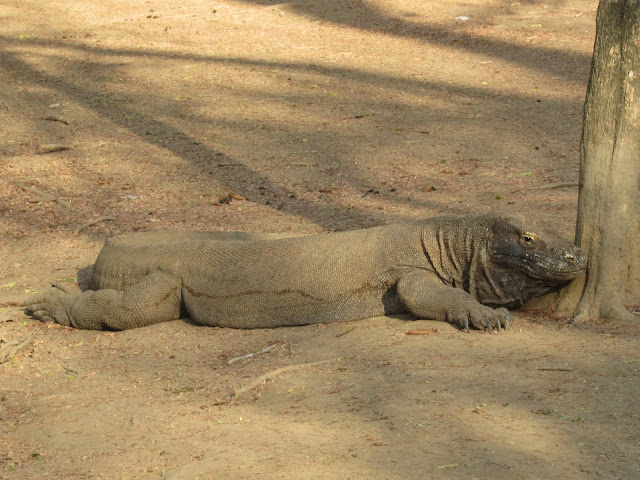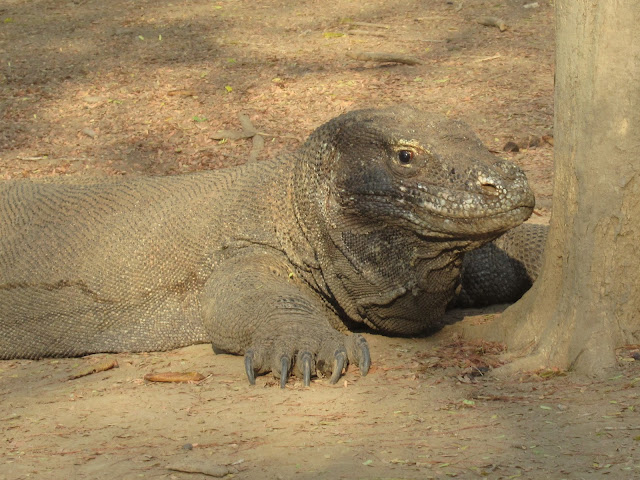Komodo & home
Thursday 3rd
Our last full day on Lesser Sundas and one we would remember
for a long time. It started with the usual early morning wake up and we left
the hotel at 5am to drive down to the harbour. We boarded a rather smart
speedboat and were soon heading across the strait past lots of little islands
to the legendary island of Komodo. Apart from a few Crested Terns there wasn’t
much to see on the way out until we approached the island. Feeding on the beach
was a Wild Boar and stood on the rocks was a Large-billed Heron.
 |
| Wild Boar |
 |
| Here be dragons |
 |
| Our speedboat |
It was low tide so we couldn’t dock at the jetty which meant
a wet landing. Luckily we were prepared for this as we were wearing shorts and
sandals. We lowered ourselves into the sea and waded to shore, the sea was knee
height so wasn’t a problem and unlike the last time we did this on Principe
where had to walk on jagged rocks, we walked onto a sandy beach.
We were welcomed by one of the rangers as the whole island
is a protected nature reserve and he took us out onto the trails. First up was
one of several Yellow-crested Cockatoos, subtly different from the familiar
Australian Sulphur-crests. Several Javan Deer strutted around and there were a
lot of birds.
 |
| Yellow-crested Cockatoo |
 |
| Javan Deer |
Because of its protected status with no hunting or collecting, birds on Komodo are relatively tame. Several species of pigeon were seen along
with Orange-footed Scrubfowl and Green Junglefowl that wandered around, often
in mixed groups.
 |
| Green Junglefowl |
 |
| Orange-footed Scrubfowl |
 |
| Gimp, or Green Imperial Pigeon |
 |
| Island Collared Dove |
We reached a little clearing and our guide pointed to a
monstrous lizard – the famed Komodo Dragon. Hesitantly we stayed back, snapping a few
distant photos before he beckoned us to approach closer. There were two here, a
large male measuring about two and half metres that barely moved and a smaller
one that was exploring a rocky pool. This one lumbered around, flicking out its
forked tongue constantly but paid no attention to us.
After our fill here we
carried on and encountered another largish dragon heading down the path
directly towards us. We cleared the path and watched as it ambled past just a
metre away. It ignored us, seeing us as neither food or a threat. The breeding
season was over for these reptiles so they were fairly placid.
We followed the path as it climbed up out of the coastal
forest and up in the dry rocky hills. It was quite hot here so we didn’t spend
too much time but long enough to see a Variable Goshawk hunting over the
hillside. We retraced our steps and headed back to the beach passing another
dragon.
 |
| Interior of Komodo |
 |
| Variable Goshawk |
We stopped for coffee at a beach-side café where we
encountered two more dragons, making it a total of six. One walked past on the
beach eyeing up a pair of Large-billed Crows that were raiding a pot of water for
a drink. Another young one scampered through the café past our table causing a
bit of mayhem as a couple of people sought refuge on the top of the table!
 |
| Barred Dove |
 |
| Large-billed Crow |
All too soon our Komodo adventure was over and we waded back
into the sea and scrambled aboard our boat. We went round to another bay where
a White-bellied Sea-Eagle was perched on a clifftop tree. Our guides went
looking for roosting owls but couldn’t find any so we headed back across the
sea to Flores. The return crossing was more productive as we encountered two pods of Indo-Pacific Bottlenose Dolphins.
 |
| Leaving Komodo |
We also had more seabirds with a few Crested Terns that were
mobbing a Pacific Reef-Heron as it flew low over the sea, a Brahminy Kite, two
Common Noddy and a frigatebird that was too distant to identify to species
level. An hour later we docked back on Flores and went for lunch at our hotel.
This was the first time we’d seen it in daylight and it was set on the beach
with an extensive garden. Joining us for lunch was a Black-faced Munia.
 |
| Harbour back on Flores |
 |
| Our hotel |
We had a decent siesta as it was hot and humid and went out
again at 3.30. We headed up into the hills and stopped by the roadside where we
could hear Flores Crow calling. Eventually we got good views of a pair.
We had
our final owling session of the trip but only got brief views of a Moluccan
Scops-Owl. Over the entire trip we’d managed to see six of the seven endemic
owls on the islands we visited although some remained unphotographed.
We finished up at a pleasant little restaurant for our last dinner
with our guide and driver before heading back to the hotel.
Friday 4th
We checked out of the hotel at 5.30 and headed back up into
the hills for our last birding session. The first stop was for a group of Leaf Lorikeets
that are aptly named as they’re good at blending ito the leaves of Eucalyptus
trees. We managed to add another couple of endemics: Flores Monarch and Russet-capped
Tesia and then finally found a perched Ornate Pitta that decided to sit still
while we could see it.
 |
| Flame-breasted Sunbird |
 |
| Ornate Pitta |
 |
| Roadside cafe with views |
 |
| and a fresh coconut to drink |
There were also a few more new trip birds with two
kingfishers: a Collared that perched up high on the hillside and an Oriental
Dwarf that whistled past us unseen. We continued to look for Flores Hawk-Eagle
but failed although we did see a few raptors, a nice perched juvenile Brown
Goshawk and two White-bellied Sea-Eagles that soared over the road and ended
our birding on the Lesser Sundas.
 |
| Brown Goshawk |
 |
| Tree Sparrow |
 |
| White-bellied Sea-Eagle |
We drove to the airport, had a repack for the flight back to
Bali. We arrived mid-evening although by the time we’d collected our bags and survived
a taxi ride with a driver who thought he could do the journey on a thimbleful
of petrol it was quite late by the time we arrived at the hotel. There was time
for dinner and fortunately we’d missed most of the set of a 70s cover-band who
were playing songs that were hits some 30 or 40 years before they were born!
Saturday 5th
A last leisurely morning. A trio of Pale-headed Munias were
seen outside the hotel window before we went down for breakfast. We actually
had to wait for a table to become free as the place was packed. We left late morning and transferred back to the airport in plenty of time for our flights home in the afternoon.
 |
| Denpasar, Bali |
 |
| Bali |
Our trip list for the Lesser Sundas was 171
species recorded including 85 new birds for me, as well as Komodo Dragon, a couple of Flying Lizards,
a handful of mammals and a selection of insects. It's a pleasant chain of islands to visit and well off the beaten track compared to Bali, just don't expect to see hundreds of birds!

































































.JPG)
.JPG)
.JPG)




.JPG)



